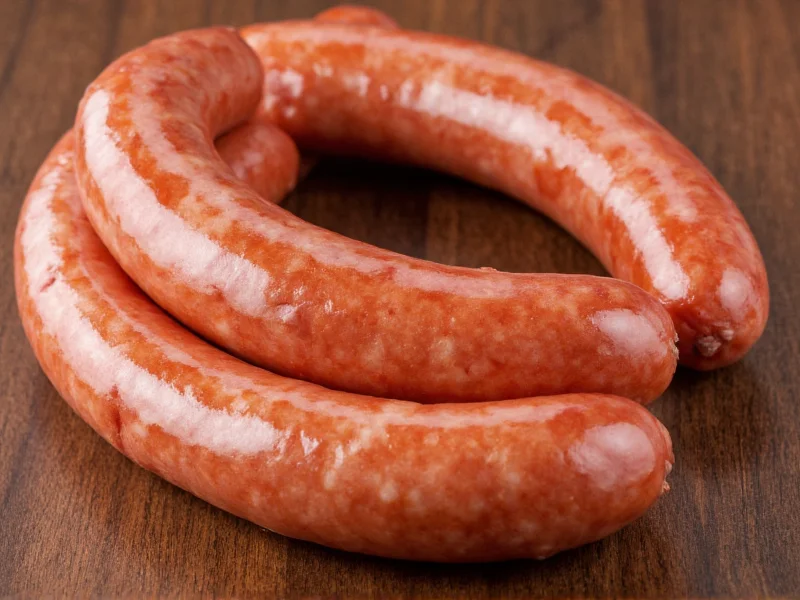Understanding Pork Sausage Varieties
Pork sausage comes in numerous forms worldwide, each with distinctive characteristics. The primary classification divides sausages into fresh, smoked, and dried categories. Fresh sausages require cooking before consumption, while smoked varieties may be ready-to-eat depending on processing methods.
| Type | Characteristics | Common Uses | Cooking Temperature |
|---|---|---|---|
| Breakfast Sausage | Finely ground, mild seasoning, often in links or patties | Morning meals, biscuits and gravy | 160°F (71°C) |
| Italian Sausage | Coarsely ground, fennel and garlic seasoning, sweet or hot | Pasta dishes, sandwiches, grilling | 160°F (71°C) |
| Bratwurst | Coarse texture, subtle spices, often smoked | Grilling, beer pairings, sauerkraut dishes | 160°F (71°C) |
| Andouille | Heavily smoked, spicy, traditional in Cajun cuisine | Gumbos, jambalayas, stews | Pre-cooked, reheating to 140°F (60°C) |
| Chorizo | Spicy, paprika-seasoned, Spanish or Mexican varieties | Tacos, paella, tapas, breakfast dishes | 160°F (71°C) |
Mastering Pork Sausage Preparation
Successful pork sausage cooking requires attention to technique and temperature. For fresh sausages, never pierce the casing during cooking as this releases flavorful juices. Instead, use indirect heat methods that allow fat to render gradually. When pan-frying, start with a cold pan and gradually increase heat to render fat slowly. For oven cooking, 375°F (190°C) typically yields optimal results in 20-25 minutes.
Professional chefs recommend the "water poach" method for perfect grilled sausages: simmer sausages in water for 10-12 minutes before finishing on the grill. This ensures thorough cooking without splitting casings. Always verify doneness with a meat thermometer rather than relying on appearance alone.
Flavor Pairings and Culinary Applications
Pork sausage's rich flavor profile pairs exceptionally well with complementary ingredients. Traditional breakfast sausage shines with maple syrup, apples, and sage. Italian sausage harmonizes with tomatoes, bell peppers, and red wine in pasta sauces. Smoked varieties like kielbasa create excellent combinations with sauerkraut, mustard, and hearty rye bread.
For innovative home cooking, consider these pairings:
- Breakfast sausage with roasted sweet potatoes and caramelized onions
- Chorizo with black beans, corn, and avocado in tacos
- Bratwurst with caramelized onions, peppers, and whole grain mustard
- Andouille in creamy pasta with spinach and parmesan
Safety and Storage Guidelines
Proper handling ensures pork sausage remains safe to eat. Fresh sausages should be refrigerated at 40°F (4°C) or below and used within 1-2 days of purchase. For longer storage, freeze at 0°F (-18°C) where it maintains quality for 1-2 months. Always separate raw sausage from ready-to-eat foods to prevent cross-contamination.
When thawing frozen sausage, use refrigerator thawing (24 hours per pound) rather than room temperature methods. Never refreeze previously frozen sausage unless it was cooked after initial thawing. Leftover cooked sausage should be refrigerated within two hours and consumed within 3-4 days.
Nutritional Profile and Dietary Considerations
A typical 3-ounce serving of cooked pork sausage contains approximately 290-350 calories, 25-30 grams of fat (including 9-12 grams saturated fat), and 12-15 grams of protein. It provides significant amounts of vitamin B12, zinc, and selenium. While flavorful, pork sausage should be consumed in moderation as part of balanced meal planning.
For those seeking lower-fat options, look for varieties labeled "reduced fat" or consider making homemade sausage with leaner pork cuts. Many traditional sausage recipes can be adapted using turkey or chicken while maintaining similar flavor profiles with different seasoning blends.
Frequently Asked Questions
What internal temperature should pork sausage reach for safe consumption?
Pork sausage must reach an internal temperature of 160°F (71°C) to ensure food safety. Use a reliable meat thermometer inserted into the thickest part of the sausage, avoiding contact with the cooking surface. This temperature destroys potential pathogens while maintaining optimal texture and juiciness.
How can I prevent pork sausage from splitting during cooking?
To prevent splitting, avoid high initial heat and never pierce the casing. Start cooking sausages in a cold pan with minimal oil, gradually increasing heat. Alternatively, simmer in water or broth for 10-12 minutes before finishing on the grill or in a pan. Proper casing preparation during manufacturing also affects integrity, but home cooks can minimize splitting through careful temperature control.
What's the difference between fresh and smoked pork sausage?
Fresh pork sausage requires cooking before consumption and typically contains only meat, fat, salt, and seasonings. Smoked sausage undergoes a curing process followed by smoking, which may make it ready-to-eat depending on processing methods. Some smoked sausages like kielbasa are fully cooked during production, while others like fresh bratwurst require cooking despite being smoked.
How long can I store cooked pork sausage in the refrigerator?
Properly stored cooked pork sausage remains safe to eat for 3-4 days in the refrigerator at 40°F (4°C) or below. Store in airtight containers or wrapped tightly in aluminum foil or plastic wrap. For longer storage, freeze cooked sausage for up to 2-3 months, though quality gradually declines over time. Always reheat to 165°F (74°C) before serving.
Can I make pork sausage at home without special equipment?
Yes, you can make excellent pork sausage at home without specialized equipment. Start with 70% lean pork shoulder and 30% fatback, chilled thoroughly. Mix with your chosen seasonings (typically salt, pepper, and regional spices), then blend using a food processor with short pulses to maintain proper texture. Form into patties or stuff into casings using a makeshift funnel from a plastic bottle. The key is maintaining cold temperatures throughout preparation.











 浙公网安备
33010002000092号
浙公网安备
33010002000092号 浙B2-20120091-4
浙B2-20120091-4